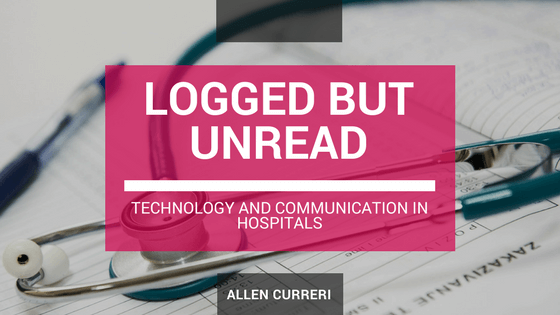A nurse returns from her lunch break to see a commotion around one of her patients’ rooms. As she watches, the doctor on call strides down the hallway, speaking urgently to another nurse. They disappear into the room.
Hastily dropping her bag onto her station, the nurse follows them and sees her patient in the midst of a severe allergic attack. She leaps into action beside her colleagues; the problem is thankfully brought under control. Afterwards, the stressed physician demands to know why the man’s allergy wasn’t recorded in his digital intake sheet – but as the nurse pulls up the patient’s record to remedy the oversight, she sees a line of text proving that it had indeed been noted during his intake. Somehow, the small, significant detail had been missed.
Medical professionals work tirelessly to save lives, often expending considerable physical, emotional, and mental energy in the process. The stakes for those working in hospitals are intense: lives hang in the balance. The stress of the job undoubtedly contributes to the fast-paced environment; doctors, nurses, and technicians alike not only have to juggle their own considerable load of tasks, but coordinate their work with their colleagues in order to ensure that each patient’s needs are properly met.
Given the stressful expectations loaded onto these professional’s shoulders and the frenetic working environment native to hospitals, it’s hardly surprising that lines of communication break down and cause dangerous setbacks like the one described above – but understanding why they occur makes them no less worrisome.
According to a study released in early 2016 by CRICO Strategies, a research company that works with Harvard-linked hospitals, communication errors were at the heart of a full 30% of reviewed malpractice cases and contributed to the deaths of 1744 patients over five years. The facts can’t be avoided: key information is slipping through the cracks. The question is, why?
Human memory itself might be at the core of the matter. According to research compiled and analyzed by Julie Parker MSc. and Enrico Coeira PhD. for the Journal of the American Medical Informatics Association, the fast-paced and highly interruptive hospital environment places a tremendous strain on a medical professional’s working – or actively used – memory. Think of a doctor’s mental to-do list as a Jenga tower: a structure that becomes increasingly unstable as tasks are taken off or added on. One task too many could inevitably tumble the tower, and leave a few blocks scattered on the floor, forgotten.
The problem is further exacerbated by a noted preference for synchronous communications: face-to-face meetings or telephone calls. However, a thirty-second happenstance encounter or brief call can’t always facilitate a productive information exchange – especially if the person listening is wrapped up in another task and can’t devote their full attention. The speaker may walk away relieved, knowing that they passed on the information. For a listener whose working memory is already operating at capacity, however, that thankfully-delivered information might just be one more Jenga block, ready to topple.
A system based primarily on face-to-face communication simply doesn’t work. Some have offered up technology-based fixes by placing more emphasis on emails, voicemails, and phone calls. In theory, doctors and nurses who carry mobile phones and check their electronic inboxes would be more easily accessible, and wouldn’t have to rely on their overworked memories for notes from chance meetings. The needed organization provided by technology would ease the burden imposed by a mental task list, improve information exchanges, and prevent dangerous miscommunications.
Or would it? According to Milisa Manojlovich, a researcher currently studying the impact of technology on communication in hospitals, it isn’t that easy for doctors to transfer important information through impersonal electronic means. As she writes:
[W]hen the consequences of errors can be so serious, it is difficult for a doctor or nurse to feel that he or she has truly “handed over” responsibility for a task without an explicit acknowledgement from the recipient. Existing asynchronous methods of communication, such as hand-written notes, voicemail, and e-mail do not easily or routinely offer this feature. The consequence may be that the task cannot be removed from working memory.
Unfortunately, Manojlovich’s observations suggest that even after the information is sent off, stress remains. Doctors can’t find the same validation in a “sent” folder that they experience during an interpersonal conversation. As a result, the cognitive burden of the task remains. Moreover, the use of mobile phones – which do, as a form of synchronous conversation, provide validation – may inadvertently add to the interruptive environment and place a greater burden on a physician’s memory.
On the flipside, online resources can be invaluable for finding, organizing, and analyzing information – Watson’s usefulness as a diagnostic aid is proof enough of that. But what can physicians do when the information is logged, but not absorbed? Should the nurse from the earlier scenario have verbally told the patient’s physician of that specific allergy, or was entering it into the digital records enough? Should she have done both, and followed up – only to find that implementing such repetitive digital and verbal recaps for every patient would tax the cognitive and time resources of the staff beyond sustainability?
In this case, technology isn’t the answer or culprit to our current communication dilemma. It can help, certainly, or cause stress if implemented ineffectively. Medical professionals need to find a way to lessen their cognitive burdens and and responsibilities productively in their intense environment. To that end, we must further consider the needs and limits of those working in medicine: How can we provide a venue for validation without relying on ineffective face-to-face meetings or interruptive phone calls? Is there a way that we can use technology to organize patient needs without making them distant and impersonal? Striking the balance between technological and human capabilities will undoubtedly improve information relays and help doctors avoid dangerous miscommunications.


